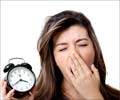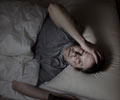Primary insomnia, a little understood medical condition, can result from neurochemical abnormality in adults.
Primary insomnia, a little understood medical condition, can result from neurochemical abnormality in adults.
While some medical conditions are known to cause insomnia and in some cases it could be a side-effect of a medication, primary insomnia itself has been a puzzle to the medical community:The essential feature of primary insomnia, or pscyhophysiological insomnia, is heightened arousal and learned sleep-preventing associations that result in a complaint of insomnia and associated decreased functioning during wakefulness.
Psychophysiological insomnia is associated with excessive worrying about sleep. As a result, they may engage in bad behaviors that include taking sleeping pills, drinking alcohol or spending too much time in bed hoping to get more sleep.
Individuals with persistent pscyophysiological insomnia tend to note decreased feelings of well-being during the day. The sleep difficulty often leads to deteriorated mood and motivation; decreased attention, vigilance energy and concentration. Despite these symptoms many report an inability to take intentional daytime naps.
In general primary insomnia is sleeplessness that cannot be attributed to a medical, psychiatric, or environmental causes (such as drug abuse or medications).
Now results of a recent study indicate that gamma-aminobutyric acid (GABA), the most common inhibitory transmitter in the brain, is reduced by nearly 30 percent in individuals who have been suffering from primary insomnia for more than six months.
Advertisement
"GABA is reduced in the brain of individuals with insomnia, suggesting overactivity is present not only at the level of excessive thoughts and emotions, but can also be detected at the level of the nervous system," said principal investigator Dr. John Winkelman of Brigham and Women’s Hospital, which is a teaching affiliate of Harvard Medical School in Boston, Massachusetts.
Advertisement
Chronic insomnia, or symptoms that last for at least a month, affects about 10 percent of all adults in industrialized countries and is the most common sleep disorder. Most often insomnia is a "comorbid" disorder, present with another medical illness, mental disorder or sleep disorder, or associated with certain medications or substances. Approximately 25 percent of people suffering from insomnia are considered to have primary insomnia, which is defined as a difficulty falling asleep or maintaining sleep in the absence of coexisting conditions.
According to Winkelman, the recognition that primary insomnia is associated with a specific neurochemical deficiency helps validate the often misunderstood complaint of insomnia.
"Recognition that insomnia has manifestations in the brain may increase the legitimacy of those who have insomnia and report substantial daytime consequences," he said. "Insomnia is not just a phenomenon observed at night, but has daytime consequences for energy, concentration and mood."
This preliminary study included 16 participants (eight men and eight women) who were screened to be free of medical and sleep disorders, as well as anxiety and mood disorders, and who were not taking prescription medication. Ages ranged from 25 to 55 years. Researchers recruited people who had difficulty initiating or maintaining sleep with resulting daytime distress or dysfunction for a period of at least six months. The average duration of participants’ symptoms was 10 years. Objective data were collected by actigraphy and overnight polysomnography. Proton magnetic resonance spectroscopy (1H-MRS) was used to non-invasively determine GABA levels. For statistical comparison the study included a well-matched control group consisting of seven women and nine men.
Significant correlations were found between GABA levels and both subjective and objective sleep measures after adjusting for age, body mass index (BMI) and gender. In subjects with primary insomnia, sleep continuity, as measured by minutes of wake after sleep onset (WASO) on sleep study, was strongly associated with GABA levels.
According to the study, reductions in brain GABA levels also have been observed with 1H-MRS in major depressive disorder (MDD) and anxiety disorders. Primary insomnia shares many features with anxiety and depressive disorders, including sleep disturbance, elevation in anxiety, and impairments in concentration and energy. In addition, primary insomnia is an important risk factor for incident mood and anxiety disorders. The study raises the possibility that GABA deficiencies seen in people with mood and anxiety disorders may be based on disturbances in sleep.
The study also reports that many of the hypnotic medications that are most effective in treating insomnia are benzodiazepine receptor antagonists (BzRAs), which increase activity at the GABA neurons. According to a new clinical guideline for the evaluation and management of chronic insomnia in adults, which was published by the American Academy of Sleep Medicine in the Journal of Clinical Sleep Medicine, hypnotic treatment should be supplemented with behavioral and cognitive therapies whenever possible.
Source-Medindia
GPL












